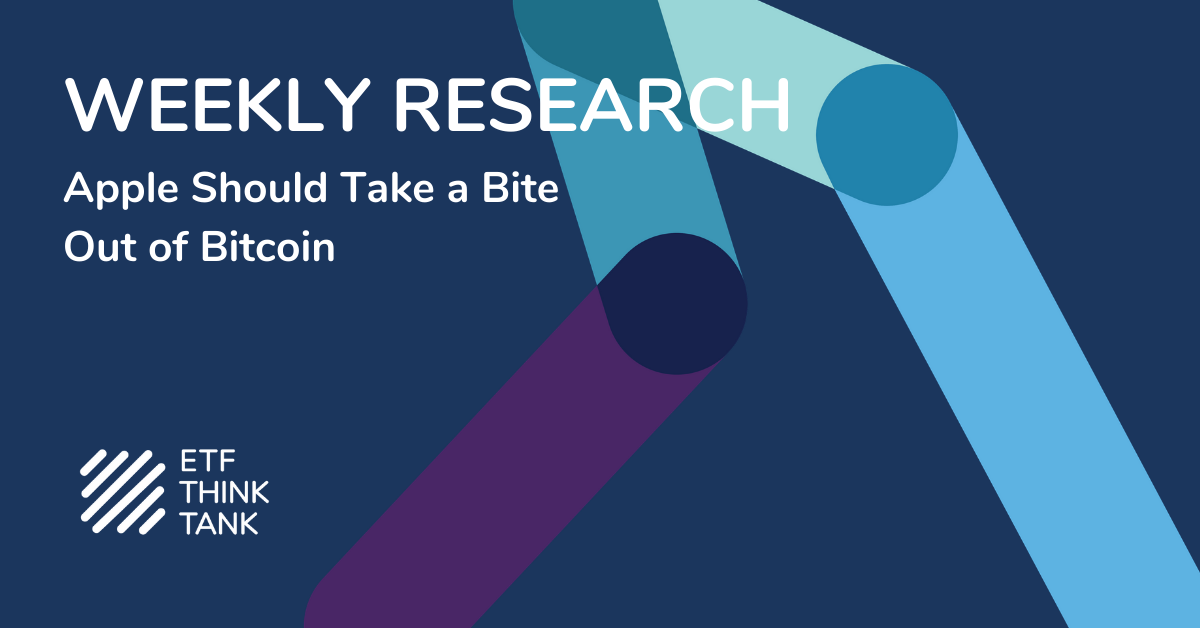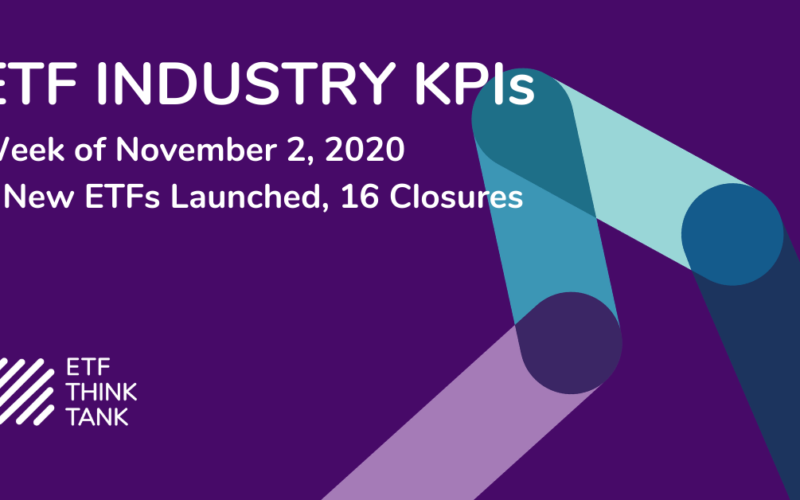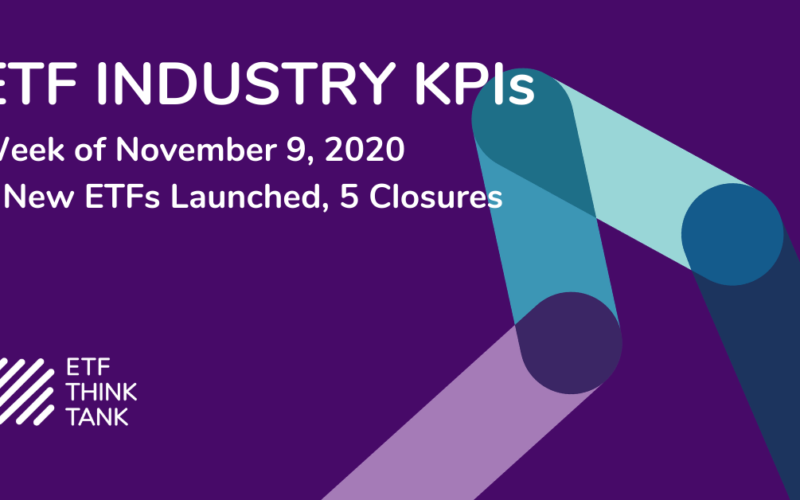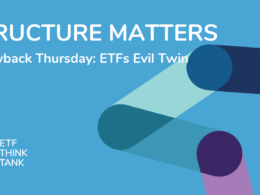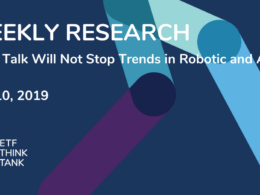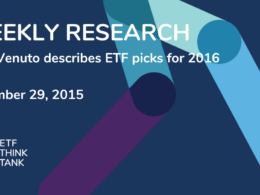Apple Should Take a Bite Out of Bitcoin as a Hedge Against Inflation

The Management at Apple needs to look closely at Bitcoin:
- The financial strength and market value of Apple make the effectiveness of deploying capital a challenge. Regulation, Culture and size make a meaningful acquisition of $50-$100 billion very unlikely.
- Aggressively buying back stock is both risky and expensive when looking at Apple’s revenue growth, $2 trillion market value, current free cash flow yield and PE.
- Apple is a technology company, not a bank. Circumstances are arguably at optimal conditions, with the spread between the pool of capital it sits on versus its borrowing cost. A change in the yield curve could erode this opportunity, and a pickup in inflation would make the value of the cash on the balance sheet a weakness rather than a strength.
- Apple’s management has a unique opportunity to think outside the box. The company’s loyal ecosystem, technological expertise and financial strength means that a relatively small risk towards digital could align it with the most disruptive technology trend since the internet.
Apple’s Unique Circumstances
Apple’s ability to manage its balance sheet with a “weighted–average cost of debt near zero” and its inability to make a sizable acquisition should make it a motivated buyer of bitcoin. Apple is not a bank that needs a AAA credit rating. Capturing the next disruptive technology wave is what it needs to focus on more than anything. Growth is why most people buy technology companies, and such an investment would diversify its balance sheet while also remaining liquid. Outlining part of the financial issue are sections of the 10K listed below as “Opportunity Section (10K).” Apple’s weighted interest income is declining like everyone else’s – 1.85% for the 12-month period, down from 2.19%, and down 56% from a year ago. The traditional fiduciary may argue that returning another $500 billion to shareholders in the form of dividends and buyback is responsible and prudent management of excess cashflow, but I would argue that Apple should speculate a little, and quietly try to own 5-10% of the outstanding Bitcoin at about $20 billion. As a shareholder, I admit this view is self-serving and non-traditional. I just don’t see how owning a larger portion of Apple through the buyback program doesn’t have a gravity problem in the laws of large numbers. Cash is trash. I want innovation and growth!

Robert Schiffman, who writes for Bloomberg Intelligence about credit, highlights the strength of Apple’s balance sheet in his article titled “Liquidity: Apple Debt and Leases of $122 Billion Tower Over Tech Peers” makes me wonder about adjusted total debt levels at Apple, which now top $120 billion following a Q4 return of $22 billion in cash ($18.5b in buy-back + $3.5B in dividends). Sure, they have made progress in spending the Shareholders 2017 peak cash balance of $285 billion, but the question remains: what to do with a free cash flow machine? The cash balance at $192 billion is a significant war chest, a cash HODL and or a nice place to “park” some bonds. What’s a creative Treasurer like Luca Maestri supposed to do? Remember – from 2012 thru 2016, the enterprise value of Apple was stuck between $300 billion and $600 billion and the stock was around $15-$25; all this made the free cash yield very compelling. This is not the case today, and Apple’s success has led to a 5x-8x move in the stock price. Hooray for US!!!!

The Opportunity (Highlights from 10K)
All this leads to the what if question: Would it be prudent for Apple to spend, “speculate,” or invest $10 to $20 billion on Bitcoin as a disruptive technology? Call it a 1-year technology spend. Crazy as this sounds, with the firm’s technology and engineering foundation, their focus on app technology and their genuine dominate ecosystem, why would this not be a self-fulfilling proper capital allocation? The Company is worth $2 trillion, and spending another $56 billion of shares on its own stock at 25-30 times earnings is marginal at best (see figure 5). It is reasonable to postulate that Bitcoin, and ultimately digital assets in general, are embraced by some of Apple’s long-term individual shareholders, but not all. However, equally as important is the belief that Bitcoin, and ultimately digital assets in general, are embraced by some of Apple’s long-term individual shareholders, but not all. The developer platform and much of its ecosystem believes in blockchain as a digital technology and many of these people are probably stockholders. In fact, it is fair to assume that management at Apple has already embraced blockchain so in capitalizing, on Bitcoin, it would only be accelerating what it already knows is a disruptive technology, and arguably aligning with what it sees as a technological future. How often will Apple have the opportunity to make an investment that is a transformation to its ecosystem as an open-source technology and benefit by its own network effect while maintaining the same liquidity on its balance sheet. Of course, value investors and traditional institutional investors may cringe at this action, which is why the buyback to infinite may remain in place. Three last points: (1) a buyback that buys low is more effective than one that buys high; (2) traditional value-based holders must be twisting right now to justify buying back shares at the current multiple versus the potential downside; (3) Apple could simply consider this action part of its R&D budget, and write off the spending or manage the mark to market the same way that MicroStrategy (MSTR) has done – meaning at cost or lower to the market. Link to transcript. Research each year is effectively written off that way.

The Cost
Robert Schiffman writes that Apple’s after-tax weighted average cost of debt is a meager 10 Bps, with no real maturities coming due until 2025. Remember, Apple principally runs a relatively asset-light business. According to Schiffman, the company has about a decade of runway on their bond maturities, equaling about $76 billion. Listen to Bloomberg radio. I get that certain institutional shareholders might get twisted up by the purchase of Bitcoin, but we need to work through the math and the opportunity versus the stock buyback. I like what Mr. Schiffman has to say about Apple’s cost of capital and credit, but whether you see Bitcoin as a hedge against inflation, a speculation or an alternative asset class, it is a technologic innovation that Apple is in a unique position to access and provide to its shareholders. I am not an analyst on Apple stock. However, if the forecast by analysts on Bloomberg proves correct and free cash flow of over $150 billion through September 30, 2022 is achieved, the question about Bitcoin for Luca Maestri and Tim Cook must be contemplated.



Apple Has Embraced Digital Currency
Apple may already be on the verge of contemplating such action. Make no mistake about it. The Company is intimately involved in the technology and had better play a foundational role in its evolution over the next decade.
- Apple Censors Some Cryptocurrency and Defi features of Coinbase App: https://news.bitcoin.com/apple-censors-cryptocurrency-defi-coinbase-app/
- Apple is one of the Top patent filers on Blockchain
Steve Job’s Vision for Apple is Aligned with Bitcoin
A couple other points to make about Apple. Steve Jobs was a great marketer, and this reminds me that the culture of Apple and Bitcoin is symbiotic. Do these statements ring a bell? See article by Camila Villafane: “Steve Jobs Marketing Lesson: 10 Timeless lessons he’s taught us and his most famous marketing quotes.” Here are a couple of highlights about specific lessons from Jobs.
- Lesson #2: Don’t Sell Product, Sell Dreams. Is Bitcoin a dream that Apple can capitalize on?
- Lesson #3: Focus on the Experience: Now that the pipes are more developed, investors in Bitcoin can open an account and trade 24/7. They can transact payments quickly, and easily keep track of the value of their accounts on their phone. Have a bad day? Look at your Bitcoin account.
- Lesson #4: Turn Consumers into Evangelists, Not Just Consumers. HODLers who want to change the world.
- Lesson #7: Find an Enemy – OMG – can you say election!!!
- Lesson 8: Keep the Design Simple, and When You Get There, “Simplify it Even More”. The concept of Bitcoin is fundamentally about supply and demand. $21 million in Supply – No More. Demand is about utilization and people. There are billions of people with a wallet, and how many of them are using Apple products?
Competition
Alibaba (BABA) may be the most aggressive patent filer in 2020, but taking a direct leap at buying Bitcoin could show leadership in the area while also directly capturing a compounding-network effect. Tim Cook is known for saying that he sometimes would rather be the “Best than the first. It is nearly impossible for a company to be the best, the first, and to make the most of a given product.” In other words, by taking a similar leap into digital assets and blockchain, Apple could play catch up both financially and by showing leadership in the ecosystem. Blockchain, crypto and bitcoin are all intertwined, and Apple needs to take a stand in this area. A direct investment in digital assets aligns both with their corporate culture, their platform ecosystem and their research budget.

Inflation and Fixed Income Volatility
Alibaba (BABA) may be the most aggressive patent filer in 2020, but taking a direct leap at buying Bitcoin could show leadership in the area while also directly capturing a compounding-network effect. Tim Cook is known for saying that he sometimes would rather be the “Best than the first. It is nearly impossible for a company to be the best, the first, and to make the most of a given product.” In other words, by taking a similar leap into digital assets and blockchain, Apple could play catch up both financially and by showing leadership in the ecosystem. Blockchain, crypto and bitcoin are all intertwined, and Apple needs to take a stand in this area. A direct investment in digital assets aligns both with their corporate culture, their platform ecosystem and their research budget.

Conclusion: Bottom Line!
Apple is a technology company whose foundational strengths are its ecosystem, product development and balance sheet. Apple is not a bank, and its growth rate is not evident in the operating number. Most importantly, traditional value-based metrics cannot justify another $500 billion buyback program. Additionally, since the Company cannot make a significant acquisition to accelerate growth in a meaningful way, why not use the strength of the balance sheet to take a leap into the world of digital assets? To be clear – I do not expect Apple to stop its buyback program. It has sufficient liquidity to do both, and while even if it had to write down a $20 billion investment in Bitcoin, such a loss is within the scope of their research spending and not much riskier than spending another $56 billion in hopes of knowing the value and price earnings multiple of Apple stock in the future.
Disclosure
The information provided here is for financial professionals only and should not be considered an individualized recommendation or personalized investment advice. The investment strategies mentioned here may not be suitable for everyone. Each investor needs to review an investment strategy for his or her own particular situation before making any investment decision.
All expressions of opinion are subject to change without notice in reaction to shifting market conditions. Data contained herein from third party providers is obtained from what are considered reliable sources. However, its accuracy, completeness or reliability cannot be guaranteed.
Examples provided are for illustrative purposes only and not intended to be reflective of results you can expect to achieve.
All investments involve risk, including possible loss of principal.
The value of investments and the income from them can go down as well as up and investors may not get back the amounts originally invested, and can be affected by changes in interest rates, in exchange rates, general market conditions, political, social and economic developments and other variable factors. Investment involves risks including but not limited to, possible delays in payments and loss of income or capital. Neither Toroso nor any of its affiliates guarantees any rate of return or the return of capital invested. This commentary material is available for informational purposes only and nothing herein constitutes an offer to sell or a solicitation of an offer to buy any security and nothing herein should be construed as such. All investment strategies and investments involve risk of loss, including the possible loss of all amounts invested, and nothing herein should be construed as a guarantee of any specific outcome or profit. While we have gathered the information presented herein from sources that we believe to be reliable, we cannot guarantee the accuracy or completeness of the information presented and the information presented should not be relied upon as such. Any opinions expressed herein are our opinions and are current only as of the date of distribution, and are subject to change without notice. We disclaim any obligation to provide revised opinions in the event of changed circumstances.
The information in this material is confidential and proprietary and may not be used other than by the intended user. Neither Toroso or its affiliates or any of their officers or employees of Toroso accepts any liability whatsoever for any loss arising from any use of this material or its contents. This material may not be reproduced, distributed or published without prior written permission from Toroso. Distribution of this material may be restricted in certain jurisdictions. Any persons coming into possession of this material should seek advice for details of and observe such restrictions (if any).






